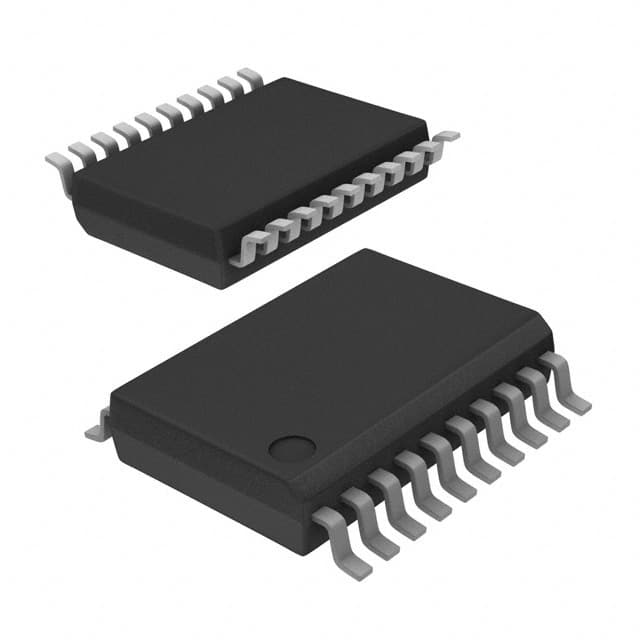Lihat spesifikasi untuk detail produk.

Encyclopedia Entry: 74LVT640DB,112
Product Overview
Category
The 74LVT640DB,112 belongs to the category of integrated circuits (ICs) and specifically falls under the family of LVT (Low Voltage Transceiver) series.
Use
This IC is primarily used as a bidirectional transceiver, facilitating the exchange of data between two separate buses. It acts as a bridge, enabling communication between different systems or devices.
Characteristics
- Low voltage operation: The 74LVT640DB,112 operates at low voltage levels, typically around 3.3V.
- High-speed performance: This transceiver offers fast data transmission rates, making it suitable for applications requiring quick data exchange.
- Bidirectional functionality: It supports data transfer in both directions, allowing for efficient communication between buses.
- Tri-state outputs: The IC features tri-state outputs, which enable multiple devices to share a common bus without interfering with each other.
Package and Quantity
The 74LVT640DB,112 is available in a standard surface mount package, commonly known as SOIC-20. Each package contains one unit of the IC.
Specifications
- Supply Voltage: 2.7V to 3.6V
- Operating Temperature Range: -40°C to +85°C
- Input/Output Compatibility: TTL, CMOS
- Maximum Data Rate: 400Mbps
Pin Configuration
The IC has a total of 20 pins, arranged as follows:
```
Pin Number | Pin Name | Description
1 | OE | Output Enable
2 | A1B1 | Bus A1/B1
3 | A2B2 | Bus A2/B2
4 | A3B3 | Bus A3/B3
5 | A4B4 | Bus A4/B4
6 | GND | Ground
7 | B4A4 | Bus B4/A4
8 | B3A3 | Bus B3/A3
9 | B2A2 | Bus B2/A2
10 | B1A1 | Bus B1/A1
11 | VCC | Power Supply
12 | DIR | Direction Control
13 | GND | Ground
14 | B1A1 | Bus B1/A1
15 | B2A2 | Bus B2/A2
16 | B3A3 | Bus B3/A3
17 | B4A4 | Bus B4/A4
18 | GND | Ground
19 | A4B4 | Bus A4/B4
20 | A3B3 | Bus A3/B3
```
Functional Features
- Bidirectional Data Transfer: The IC allows data to be transmitted in both directions, facilitating communication between two buses.
- Output Enable (OE) Control: The OE pin enables or disables the outputs, providing control over the data flow.
- Direction Control (DIR): The DIR pin determines the direction of data transmission, allowing for flexible operation.
Advantages and Disadvantages
Advantages
- Low voltage operation makes it compatible with modern electronic systems.
- High-speed performance ensures efficient data transfer.
- Tri-state outputs enable multiple devices to share a common bus without interference.
Disadvantages
- Limited voltage range (2.7V to 3.6V) may restrict compatibility with certain systems.
- The SOIC-20 package may not be suitable for all applications, requiring additional considerations for PCB layout and space constraints.
Working Principles
The 74LVT640DB,112 operates based on the principles of digital logic. It utilizes internal circuitry to control the direction of data flow and enable/disable the outputs. By synchronizing the signals from two separate buses, it allows bidirectional communication between them.
Application Field Plans
The 74LVT640DB,112 finds application in various fields, including: 1. Data communication systems 2. Networking equipment 3. Industrial automation 4. Automotive electronics 5. Consumer electronics
Alternative Models
Other alternative models that offer similar functionality to the 74LVT640DB,112 include: - 74LVTH640DB,112 - 74LVC640DB,112 - 74LVX640DB,112
These alternatives can be considered based on specific requirements and compatibility with the target system.
Sebutkan 10 pertanyaan dan jawaban umum terkait penerapan 74LVT640DB,112 dalam solusi teknis
Sure! Here are 10 common questions and answers related to the application of 74LVT640DB,112 in technical solutions:
Q: What is the function of the 74LVT640DB,112? A: The 74LVT640DB,112 is an octal bus transceiver with 3-state outputs. It can be used to enable bidirectional transfer of data between two buses.
Q: What is the operating voltage range for the 74LVT640DB,112? A: The 74LVT640DB,112 operates within a voltage range of 2.7V to 3.6V.
Q: How many channels does the 74LVT640DB,112 have? A: The 74LVT640DB,112 has 8 channels, allowing for bidirectional data transfer on each channel.
Q: What is the maximum data transfer rate supported by the 74LVT640DB,112? A: The 74LVT640DB,112 supports a maximum data transfer rate of 400Mbps.
Q: Can the 74LVT640DB,112 be used in both parallel and serial communication systems? A: Yes, the 74LVT640DB,112 can be used in both parallel and serial communication systems, depending on the application requirements.
Q: Does the 74LVT640DB,112 have built-in ESD protection? A: Yes, the 74LVT640DB,112 features built-in ESD protection, making it more robust against electrostatic discharge.
Q: What is the power supply current consumption of the 74LVT640DB,112? A: The power supply current consumption of the 74LVT640DB,112 is typically around 10mA.
Q: Can the 74LVT640DB,112 be used in automotive applications? A: Yes, the 74LVT640DB,112 is suitable for automotive applications as it meets the necessary standards and requirements.
Q: Does the 74LVT640DB,112 support hot insertion and removal of devices? A: Yes, the 74LVT640DB,112 supports hot insertion and removal of devices without causing damage to the IC.
Q: What is the package type of the 74LVT640DB,112? A: The 74LVT640DB,112 is available in a TSSOP (Thin Shrink Small Outline Package) package type.
Please note that the answers provided here are general and may vary depending on the specific datasheet and application requirements.

